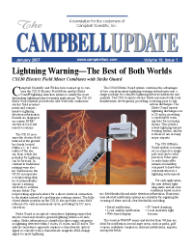Whether for email, shopping, work, or entertainment, most people deal with the Internet on a daily basis; nevertheless, the average person knows very little about the elusive workings of this complex system. That is why I initially found the task of making my CR1000's data available on an Internet web page overwhelming, if not impossible. However, after talking with application engineers and others at Campbell Scientific, I discovered that the task could be made incredibly easy by using the NL115 Ethernet Interface and CompactFlash®module.
Beginning with a traditional hardware setup (i.e., CR1000 directly connected to a PC with a serial RS-232 cable, power supply, etc.), I obtained an NL115 module, which I connected to the CR1000's peripheral port. The NL115 has a 10BaseT Ethernet port that I connected to a local Ethernet hub. Next, I used my computer and Campbell Scientific's Device Configuration Utility software to enter in the datalogger's IP address, the subnet mask, and the IP Gateway. These three values are used for addressing the datalogger and were obtained from my network administrator. Finally, I used LoggerNet's Setup Screen to add the IP port and enter its address (all of the detailed setup instructions can be found in the NL115 manual).
As in a traditional setup, I wrote a program with CRBasic and sent it to the datalogger using LoggerNet's Connect Screen. I checked and confirmed that the program was running properly. Up to this point, all setup operations and communications had been done through the direct RS-232 connection. I then closed down LoggerNet and crossed my fingers that everything had been done correctly. I was now ready to attempt Ethernet communication.
I launched my Internet browser and keyed in my CR1000's IP address. To my delight, a Web site with the headingCR1000 Datalogger Home Page, popped up along with a list of data tables. All the tables that I had defined in my program were shown, and each one reported the most recently logged results. I almost couldn't believe how easy and fast the whole process was, and I found myself thinking what so many others have said about the Internet: “It must be magic. . . .”
Ryan is a chemistry student at Utah State University who works part-time at CSI.

